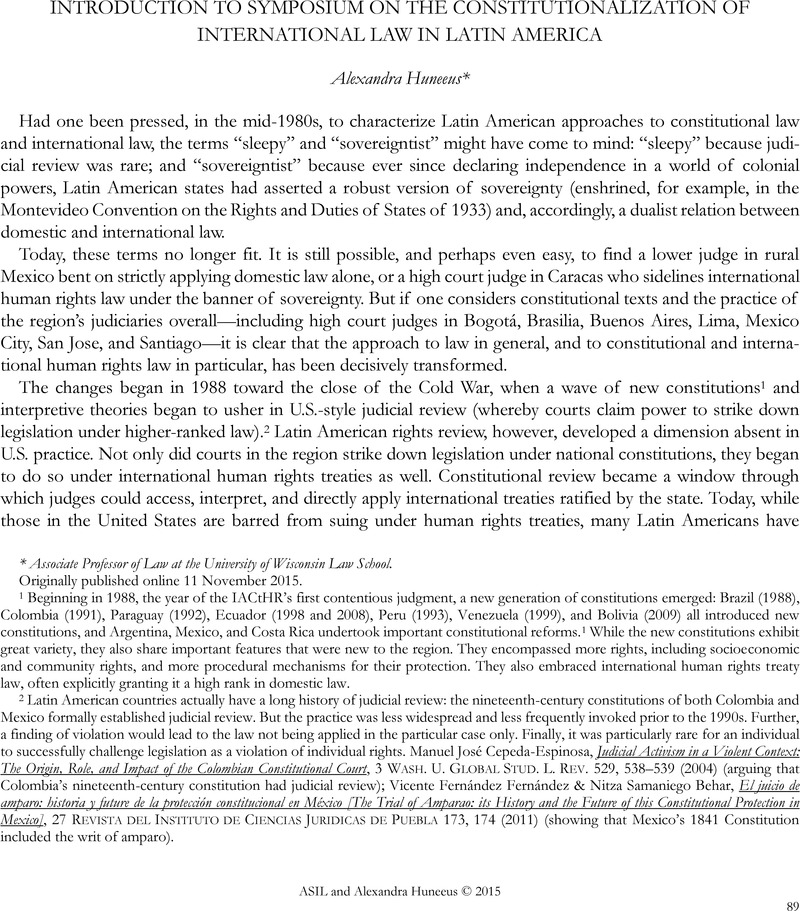Article contents
Introduction to Symposium on the Constitutionalization of International Law in Latin America
Published online by Cambridge University Press: 20 January 2017
Abstract

- Type
- Symposium on the Constitutionalization of International Law in Latin America
- Information
- Copyright
- Copyright © American Society of International Law 2015
References
1 Beginning in 1988, the year of the IACtHR’s first contentious judgment, a new generation of constitutions emerged: Brazil (1988), Colombia (1991), Paraguay (1992), Ecuador (1998 and 2008), Peru (1993), Venezuela (1999), and Bolivia (2009) all introduced new constitutions, and Argentina, Mexico, and Costa Rica undertook important constitutional reforms. While the new constitutions exhibit great variety, they also share important features that were new to the region. They encompassed more rights, including socioeconomic and community rights, and more procedural mechanisms for their protection. They also embraced international human rights treaty law, often explicitly granting it a high rank in domestic law.
2 Latin American countries actually have a long history of judicial review: the nineteenth-century constitutions of both Colombia and Mexico formally established judicial review. But the practice was less widespread and less frequently invoked prior to the 1990s. Further, a finding of violation would lead to the law not being applied in the particular case only. Finally, it was particularly rare for an individual to successfully challenge legislation as a violation of individual rights. Cepeda-Espinosa, Manuel José, Judicial Activism in a Violent Context: The Origin, Role, and Impact of the Colombian Constitutional Court, 3 Wash. U. Global Stud. L. Rev. 529, 538–539 (2004)Google Scholar (arguing that Colombia’s nineteenth-century constitution had judicial review); Fernández, Vicente Fernández & Behar, Nitza Samaniego, El juicio de amparo: historia y future de la protección constitucional en México [The Trial of Amparao: its History and the Future of this Constitutional Protection in Mexico], 27 Revista del Instituto de Ciencias Juridicas de Puebla 173, 174 (2011)Google Scholar (showing that Mexico’s 1841 Constitution included the writ of amparo).
3 Judicial review in the region has taken the form of what Mark Tushnet calls strong-form review, which, as in U.S. practice, “insists that the courts’ reasonable constitutional interpretations prevail over the legislatures’ reasonable ones. . . . their interpretive judgments are final and unrevisable.” Tushnet, Mark, Weak Courts, Strong Rights: Judicial Review and Social Welfare Rights in Comparative Constitutional Law 21 (2009)Google Scholar.
4 The United States is a State Party to the OAS Charter, which commits states to uphold human rights, and creates the Inter-American Human Rights Commission. While the Charter does not set out a bill of rights, many hold the view that the American Declaration of Human Rights articulates the rights alluded to by the Charter. The United States has not ratified the American Convention of Human Rights and has not accepted the jurisdiction of the Inter-American Court of Human Rights. Thus, while it participates in the OAS Human Rights System and is subject to supervision by the Commission, it has not taken on the full set of obligations.
5 Art. 72 (22), Constitución Nacional [Const. Nac.] (Arg.).
6 Mac-Gregor, Eduardo Ferrer, Conventionality Control: The New Doctrine of the Inter-American Court of Human Rights, 109 AJIL Unbound 93 (2015)CrossRefGoogle Scholar.
7 Dulitzky, Ariel E., An Alternative Approach to the Conventionality Control Doctrine, 109 AJIL Unbound 100 (2015)Google Scholar.
8 von Bogdandy, Armin, Ius Constitutionale Commune en América Latina: Observations on Transformative Constitutionalism , 109 AJIL Unbound 109 (2015)CrossRefGoogle Scholar.
9 Gargarella, Roberto, Democracy and Rights in Gelman v. Uruguay, 109 AJIL Unbound 115 (2015)CrossRefGoogle Scholar.
10 Glendon, Mary Ann, The Forgotten Crucible: The Latin American Influence on the Human Rights Idea, 16 Harv. Hum. Rts. J. 27, 31 (2003)Google Scholar; see also Sikkink, Kathryin, Latin American Countries as Norm Protagonists of the Idea of International Human Rights, 20 Global Governance 389 (2014)Google Scholar; Espiell, Hector, La Declaración Americana: Raíces Conceptuales y Políticas En La Historia, La Filosofia Y El Derecho Americano, Revista del Instituto Interamericano de Derechos Humanos, Edicion Especial 41 (1989)Google Scholar.
11 Kelly, Patrick William, “Magic Words”: The Advent of Transnational Human Rights Activism in Latin America’s Southern Cone in the Long 1970s, in The Breakthrough: Human Rights in the 1970s 88 (Eckel, Jan & Moyn, Samuel eds., 2013)Google Scholar.
12 Id.
- 2
- Cited by




